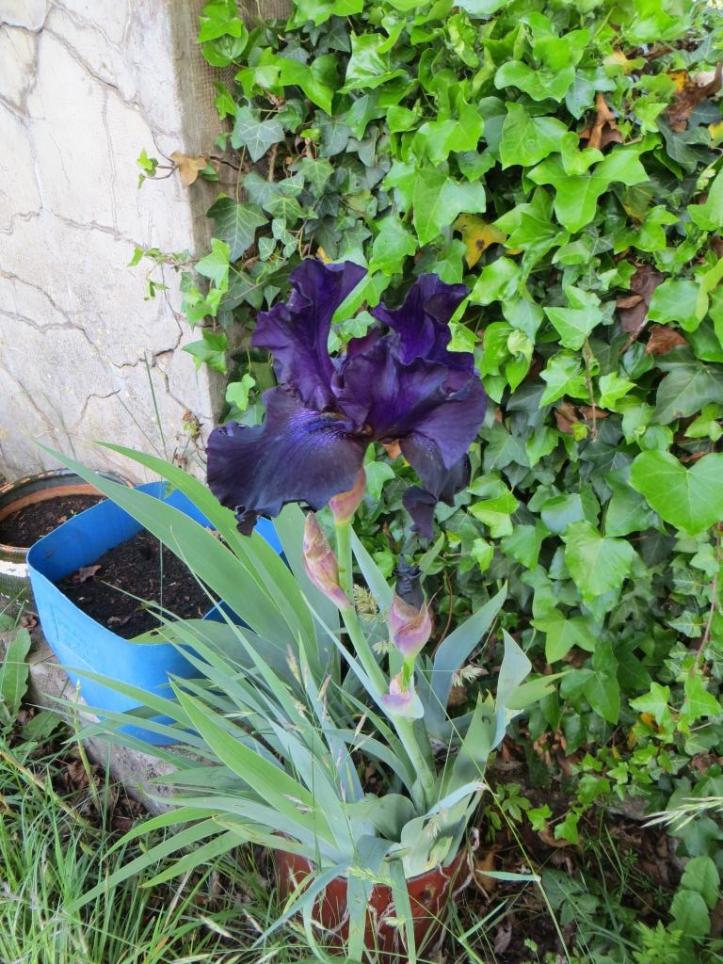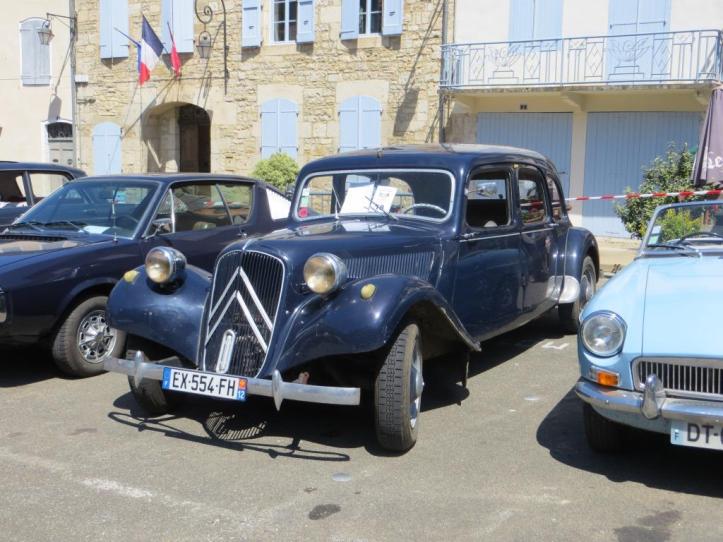
Pentecôte (Whitsun) is the time for our village’s annual fête. It’s become a tradition for Caylus Notre Village (CNV), an association that promotes and protects local monuments, to organise a series of guided walks around the commune as part of the festivities. We duly turned up at the former lavoir (wash house), one of CNV’s projects, and put our best foot forward. Three walks were billed: 18 km, 12 km and 6 km. The SF and I opted for the middle one, feeling that the longest one would be a bridge too far.
We set off at a cracking pace, barely flagging for the steep hill out of the village. Fortunately, we stopped halfway up to look at an Asiatic hornet’s nest high up in a tree. I couldn’t get a good shot, but it was pretty big. These insects are becoming a pest. A sting from one is potentially fatal. And they are particularly fond of killing honey bees – by decapitating them.
Moving swiftly on, we arrived with some relief on the causse (plateau) above the village, where the terrain is mainly flat. The weather was perfect for walking: sunny, but not too hot, with a light breeze. It’s pretty dry up there, but everywhere is very green this year, owing to the copious winter (and early spring) rainfall. The flowers are resplendent this year.



The next curiosity was this plastic contraption sported by a calf. I have never seen this before. Moïse, who led the walk, explained that this was to prevent him from suckling the cows. The spiky bits stick into the cows’ udders and they move away to escape. Hmm.

Land of dry stone
The footpaths on the causse follow ancient roads bordered by walls constructed with the local stone that farmers turned up in their fields. Many of those fields have long since reverted to woodland, since the population has declined considerably since the late 19th century.
One of the advantages of this type of walk is that you get to see tiny hamlets and other places of interest, which going around in the car never reveals. Caylus extends over a wide area and has a large number of little settlements. Despite the population decline, many of them are being restored to their former glory.

Another local association, APICQ, has restored this old windmill, le Moulin de Genebrières, set on one of the higher parts of the causse, which is now within the military camp’s territory. In fact, while I was snapping it, I realised that an army lorry was parked close to it and several militaires were in sight. It’s probably an offence to take photos of them, so I hopped it before I could be clapped in irons.

Close by, another APICQ project is a lavoir and a citerne. This was clearly a part of the causse with underground springs, since we saw a series of wells, constructed more than a century ago. Access to sufficient water was always an issue on the arid plateau.


Proximity to water was probably the original reason for the establishment of the hamlet of Genebrières. The village bread oven has been completely restored, a testament to the fact that these hamlets had to be self-sufficient. No popping out to the shops for a loaf.


This was the furthest point on the walk, after which we turned back towards Caylus along another track. A view of the church spire of Lassalle, visible for miles around accompanied us.

Back in Caylus, a little footsore, since we had actually done closer to 14 km, we stopped to have a look at the vintage car rally in la place de la Halle. They don’t make ‘em like this any more.



You might also like:
Restoration of the Lavoir in Caylus
Lovely Lavoirs
Celebrating the Past at our Village Fête
Our Village Fête: Yesterday and Today
Copyright © 2018 Life on La Lune, all rights reserved
[…] Whitsun Walk on the Wild Side […]
LikeLike
My first time to view your blog. I enjoyed it very much.
LikeLiked by 1 person
Well, your walk has certainly whet my appetite again for France. We are back in September doing a resit, which is always lovely as we never get to see everything the first time around. I am with Osyth with regard to the vintage car, actually more the Squire than myself if I was truthful!
LikeLiked by 1 person
September is usually one of the nicest months, because it’s still warm and the weather is generally more settled than at other times of year. It’s nice to get to know an area. You miss things first time around.
LikeLiked by 1 person
Well, hopefully you may catch one of my posts about our return 🙂
LikeLiked by 1 person
What a lovely ramble and I am glad the weather was clement but not over-hot for it. That thing in the calf’s nose is something I have never seen before. My favourite pictures are of the vintage cars. Particularly that gorgeous ‘Traction Avant’ from Aveyron – HB2 and I are keen to track one down (to go with the 2CV which we also have to locate).
LikeLiked by 1 person
The vintage cars are wonderful. Some friends had a Traction Avant dating from around 1936, but they sold it, since they barely used it. The one in the post was dated 1956, I think. Citroën stopped making them in 1957. Good luck with your search!
LikeLiked by 1 person
All in good time … we need to find that pesky house first!!!
LikeLiked by 1 person
It’s waiting there for you somewhere and you’ll know it when you need it. I guess the Traction must come second…
LikeLiked by 1 person
It’s fair to say that if we found one that was perfect we probably would throw caution and buy it – we can always store it in Marcolès but I do try to stay on the right side of sensible some of the time!!
LikeLiked by 1 person
Do you happen to know the name of the first flower on your walk, the pink one that looks a bit like a freesia? We have loads of them by the side of the road and I haven’t been able to find out what they are called.
LikeLiked by 1 person
I believe it’s a kind of orchid. It could be Cephalanthera rubra, Red Helleborine, but the leaves don’t look right. If it is, then it is more common in France than in the UK, where it’s one of the rarest. I’ll try to find out more – in the meantime, if other readers can identify it, please do leave a comment.
LikeLike
My first thought was an orchid, but the stem looks woody, not the usual thick orchid style and the flowers look too flimsy. For a common flower, the plant guides are very discreet about it!
LikeLiked by 1 person
Yes, I’ve had difficulty tracking it down. The stems of the ones in the photo above are orchid-like and the leaves are narrow and tapering. I’ll continue my researches.
LikeLike
Let me know if you find out. It must be quite common, but I see no sign of it in google galleries.
LikeLiked by 2 people